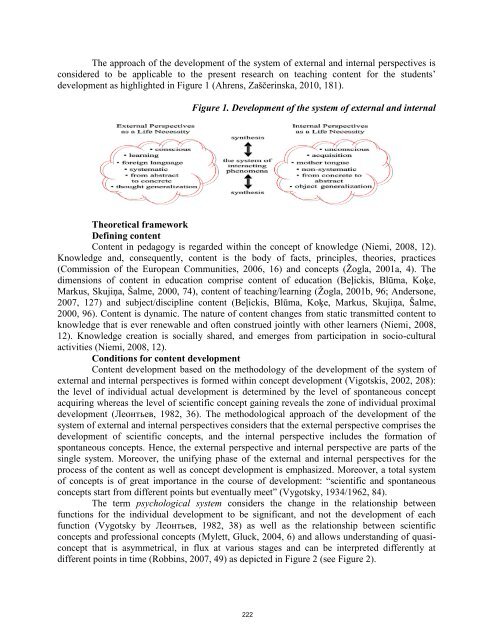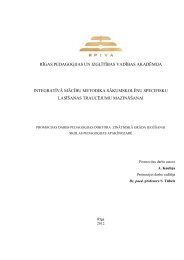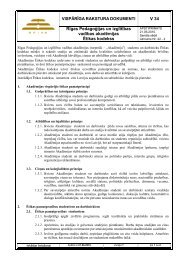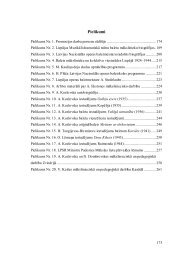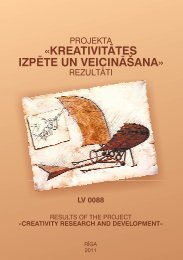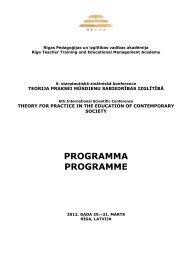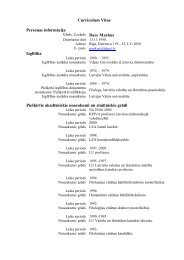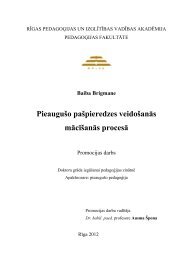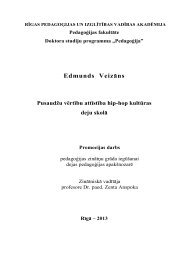saturs - rpiva
saturs - rpiva
saturs - rpiva
- No tags were found...
Create successful ePaper yourself
Turn your PDF publications into a flip-book with our unique Google optimized e-Paper software.
The approach of the development of the system of external and internal perspectives is<br />
considered to be applicable to the present research on teaching content for the students’<br />
development as highlighted in Figure 1 (Ahrens, Zaščerinska, 2010, 181).<br />
Figure 1. Development of the system of external and internal<br />
Theoretical framework<br />
Defining content<br />
Content in pedagogy is regarded within the concept of knowledge (Niemi, 2008, 12).<br />
Knowledge and, consequently, content is the body of facts, principles, theories, practices<br />
(Commission of the European Communities, 2006, 16) and concepts (Ţogla, 2001a, 4). The<br />
dimensions of content in education comprise content of education (Beļickis, Blūma, Koķe,<br />
Markus, Skujiņa, Šalme, 2000, 74), content of teaching/learning (Ţogla, 2001b, 96; Andersone,<br />
2007, 127) and subject/discipline content (Beļickis, Blūma, Koķe, Markus, Skujiņa, Šalme,<br />
2000, 96). Content is dynamic. The nature of content changes from static transmitted content to<br />
knowledge that is ever renewable and often construed jointly with other learners (Niemi, 2008,<br />
12). Knowledge creation is socially shared, and emerges from participation in socio-cultural<br />
activities (Niemi, 2008, 12).<br />
Conditions for content development<br />
Content development based on the methodology of the development of the system of<br />
external and internal perspectives is formed within concept development (Vigotskis, 2002, 208):<br />
the level of individual actual development is determined by the level of spontaneous concept<br />
acquiring whereas the level of scientific concept gaining reveals the zone of individual proximal<br />
development (Леонтьев, 1982, 36). The methodological approach of the development of the<br />
system of external and internal perspectives considers that the external perspective comprises the<br />
development of scientific concepts, and the internal perspective includes the formation of<br />
spontaneous concepts. Hence, the external perspective and internal perspective are parts of the<br />
single system. Moreover, the unifying phase of the external and internal perspectives for the<br />
process of the content as well as concept development is emphasized. Moreover, a total system<br />
of concepts is of great importance in the course of development: “scientific and spontaneous<br />
concepts start from different points but eventually meet” (Vygotsky, 1934/1962, 84).<br />
The term psychological system considers the change in the relationship between<br />
functions for the individual development to be significant, and not the development of each<br />
function (Vygotsky by Леонтьев, 1982, 38) as well as the relationship between scientific<br />
concepts and professional concepts (Mylett, Gluck, 2004, 6) and allows understanding of quasiconcept<br />
that is asymmetrical, in flux at various stages and can be interpreted differently at<br />
different points in time (Robbins, 2007, 49) as depicted in Figure 2 (see Figure 2).<br />
222


